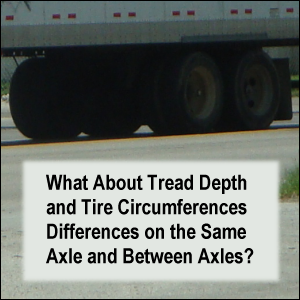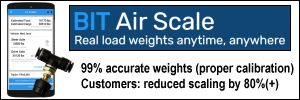This page — “Tread Depth 2” — is a response to a question posed to us as a result of our original tread depth article, about truck tires on the same axle and between axles having the same depth of tread. 
It is a guest post from
Curtis Decker,
Product Development Manager,
Continental Commercial Vehicle Tires.
We received it as a result of our Twitter correspondence with
Jackie Pobiega,
Media Specialist,
Commercial Vehicle Tire Group,
Continental Tire the Americas, LLC.
Across the same axle, it should be standard practice for all tires to have the same rolling circumference, and this is most easily accomplished by using the same tire specification tires matched to at least 4/32nds of tread depth. If for some reason, an operator chooses to run different specification tires across the same axle, then the circumference of the tires should be matched to at least 3/4″. Failure to do so will cause the axle ends to rotate at different speeds and could shorten the life of drive axle differential components unnecessarily. Additionally, the different height of the axle ends could act on the vehicle geometry and create the same issues as poor alignment. This additional stress will shorten the typical service life of wearable drive line components in steering linkage and suspension systems.
When considering the difference in tread depth between two axles in a tandem configuration, you should consider the reason for that difference in the first place. Typically, the two axles will wear at slightly different rates, and fleets are encouraged to rotate tires between the two axles when the difference becomes greater then 5/32nds in tread depth. This is done mainly to maximize the life across all 4 wheel end positions in a tandem drive axle application. This methodology assumes that all four wheel end positions receive new tires at the same time. All (8) standard tires, or (4) wide base tires.
It is also possible that the different wear rate could be attributed to reasons other than typical wear. Examples include problems with bearing maintenance, brake maintenance, ride height controls, and alignment. If these problems are allowed to continue, normal deterioration of the problem will lead to unplanned maintenance and possible safety concerns.
Of course, there are always exceptions to the standard maintenance model. Some Fleets/Owner Operators will choose to run drive patterns on one axle and rib tires on the other axle in a tandem drive application. It’s possible that only one of the axles are driven, and the rib specification is sufficient for the free rolling axle. In this case, it can be difficult to match the rolling circumference across all (4) wheel ends. However, please keep in mind that the individual axle should receive equivalent diameter tires for the reasons stated above.
If you have further questions about tires, please feel free to send them to us on Twitter, @ContiTruckTires, or via email to commercial.tireinfo@conti-na.com. We are always glad to hear from professional truckers and to listen to your concerns.
Return from Tread Depth 2: Same Axle and Between Axles Tire Circumferences to our Preventive Maintenance page or our Truck Drivers Money Saving Tips home page.







